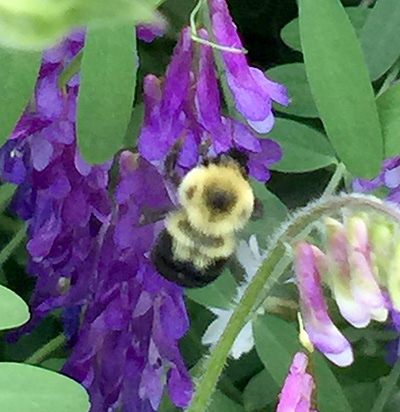Cow vetch pops up in gardens, but is it a friend or foe?
Pretty in purple, cow vetch is an attractive plant that can serve as a feeding spot for beneficial insects and butterflies, but it can also overcrowd other landscape plants.

Many gardeners are surprised to find a vine they did not plant growing in their garden. If they let it grow, they’re amazed to find they had an attractive plant that was covered by bright purple, violet and lavender flowers during summer. The question for most gardeners: is this friend or foe?
Smart gardeners will pick up one of their reference books and do some investigation. An essential reference book to own is “A Field Guide to Wildflowers” by Peterson and McKenny, published by Houghton Mifflin. The book is divided by flower colors and flower and leaf shapes. If gardeners consulted their reference book and looked under violet and blue pea-like flowers, they would discover their mystery vine was cow vetch or tufted vetch or bird vetch, Vicia cracca.
The vine produces an incredible multitude of one-sided flowers on stems that make one think of a clothes brush in living color. Each vine terminates with two tendrils that wrap around anything and everything for support. There are eight to 12 pairs of leaflets in a leaf. Even a novice gardener would see the resemblance to garden peas.
This annual plant grows best in full sun and is hardy in zones 4-6 and prefers dry, sandy soils and disturbed soil. It could grow to 4 or more feet tall during a single summer. The plant stem is smooth, as are the narrow leaves. After the flowers, small, pea-like pods are produced with six to eight small, round seeds inside. The seeds are black when ripe. Cow vetch self-seeds with incredible reliability.
This alien vine is from Eurasia and is currently found from Japan to Great Britain and in many other locations in the world. It was invited here as forage for cattle, but the attractive plant serves more than one purpose. It provides a feeding spot with its prolific flowers for many beneficial and attractive insects like honey bees, mason bees and bumble bees. It also attracts a large number of native butterflies, including Baltimore checkerspots, clouded skippers, gray hairstreak, crossline skippers, orange sulfurs, Delaware skippers, eastern tailed-blues and wild indigo duskywings.

A bumble bee on cow vetch.
Cow vetch belongs to the legume family, which means its roots have nitrogen-fixing properties. The white taproot can be well over 1 foot in length. Besides cattle forage, it has been used as a cover crop to improve soil and also the seeds are used as budgie or parakeet food. No reputable source indicates it is edible for people. In Finland, the tiny seeds give rise to its common name being mouse’s pea.
The friend or foe question is still up for debate. Michigan State University Extension suggests that every case is different. It can be a friend if there is adequate garden room and something to climb on, and you’d be supporting many native insects with a tasty treat. You can also mow cow vetch and turn it into soil as a cover crop to loosen compacted soil and add nitrogen. But friend becomes foe if cow vetch is growing wildly and tumbling over important landscaping and blocking sunlight to those plants. This could cause healthy plants to decline. Every smart gardener gets to make that call for their home habitat. Be a smart gardener and make the right choice.



 Print
Print Email
Email


